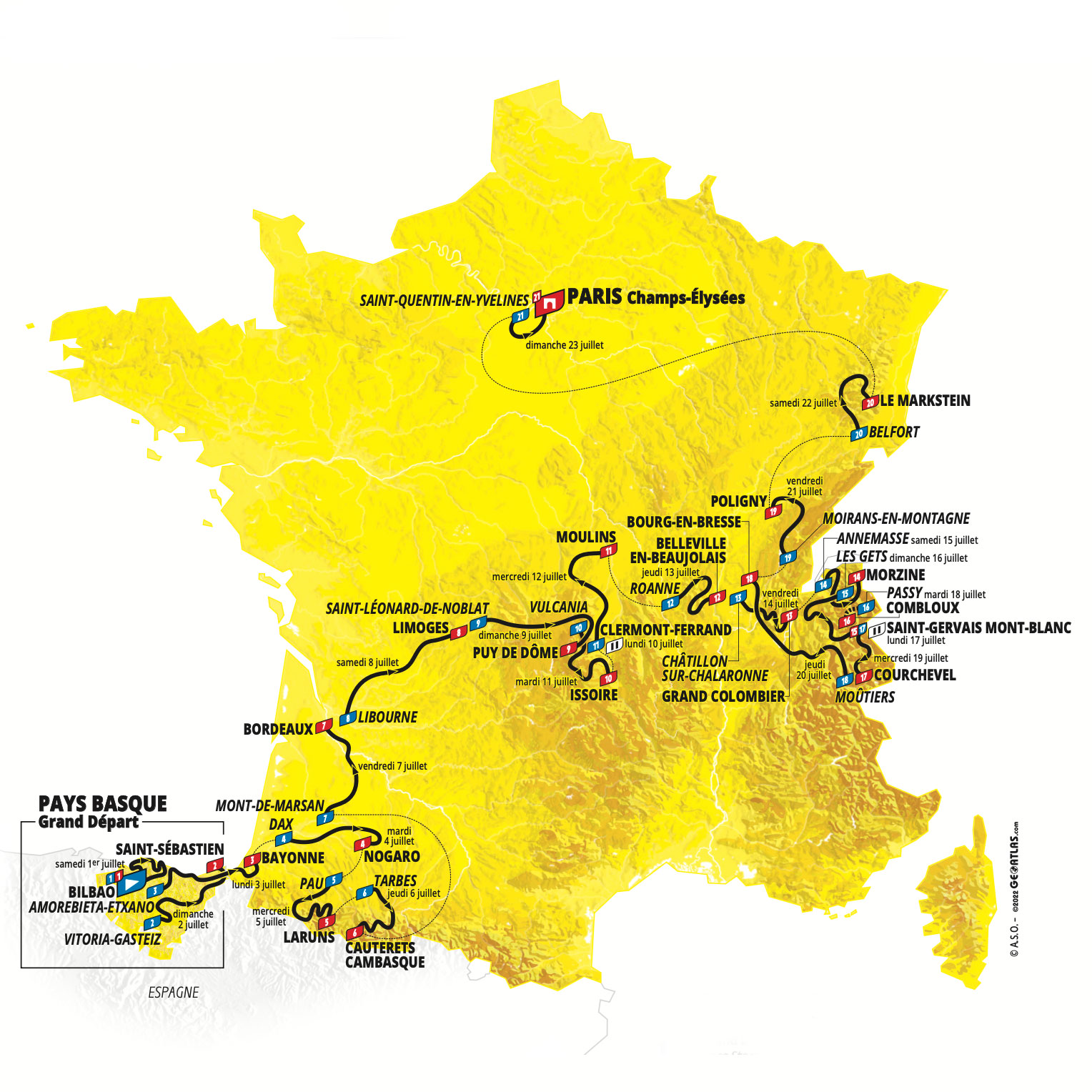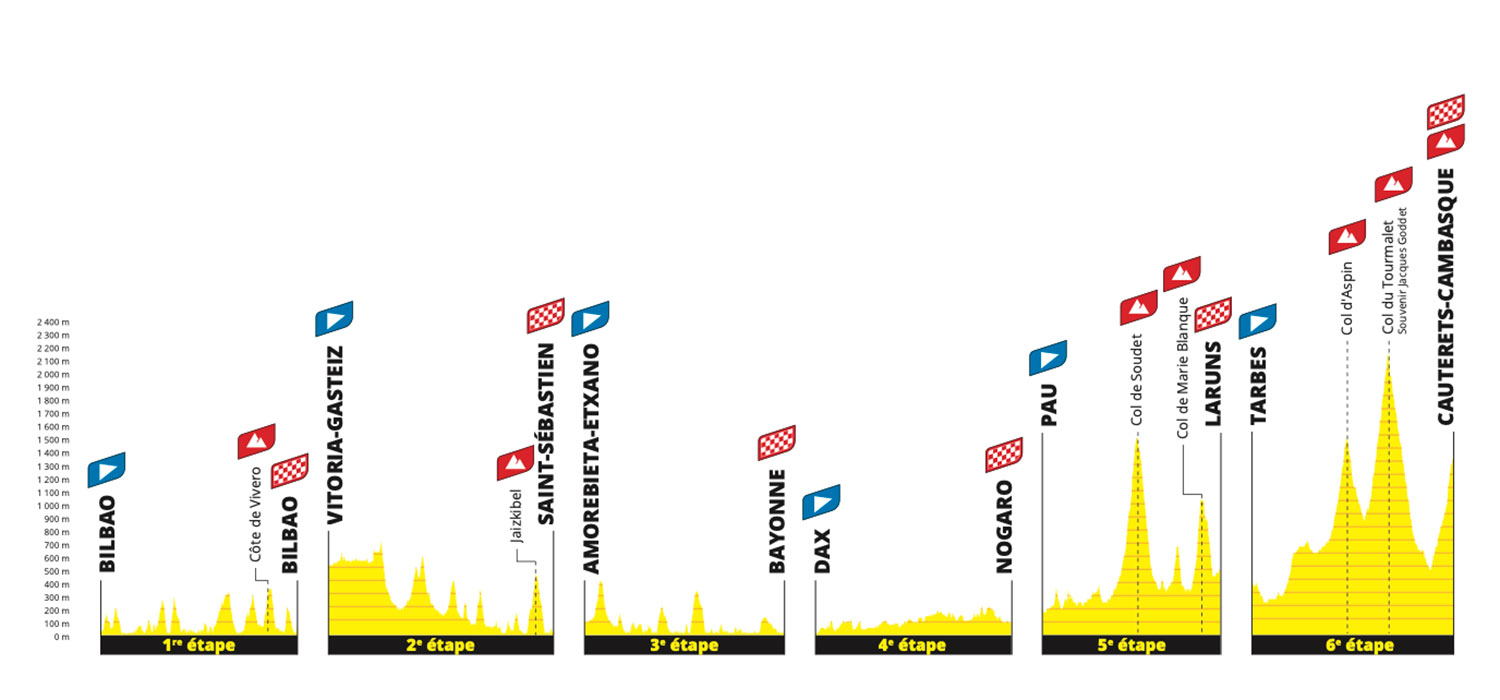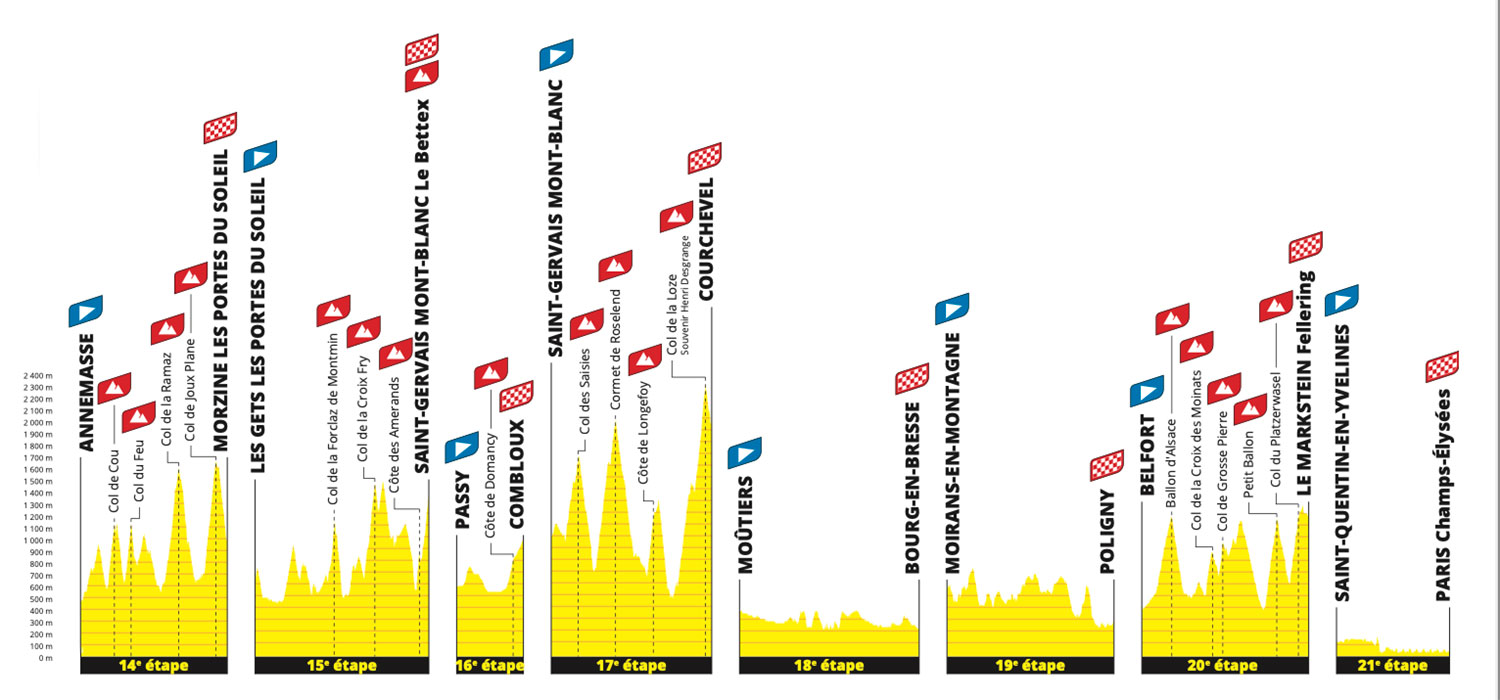Tour de France 2023 route announcement – Everything you need to know
Mountainous profile, only 22km of time trialling and four summit finishes - all the details of the 110th Grande Boucle

There were gasps from the audience in the Palais des Congrès in Paris when the men’s 2023 Tour de France route was unveiled and the severity of the course was confirmed.
The 110th edition of cycling’s biggest race includes just a single 22km hilly time trial in the Alps and mountain stages in all five of France’s mountain ranges on the road between the Grand Départ in the Basque Country and the finish in Paris.
Race director Christian Prudhomme openly admitted that the 2023 Tour route was for the climbers as he revealed the multiple mountain top finishes and steep roads.
The very limited amount of time trialling and preponderance of mountains no doubt pleased French riders Thibaut Pinot, David Gaudu and Romain Bardet. However, Remco Evenepoel, Primoz Roglič and Geraint Thomas are more likely to target the Giro d’Italia, which has three times the amount of time trialling and arguably fewer mountains.
Official information from race organiser ASO claimed the 3,404km route includes eight flat stages for the sprinters, four hilly stages suited to breakaways and eight mountain stages. Four of these include summit finishes: in the Pyrenees at Cauterets-Cambasque, on the legendary Puy de Dôme volcano in the Massif Central, on the Grand Colombier in the Jura and at Saint-Gervais Mont-Blanc in the Alps.
The other mountain stages are also extremely difficult, even if some are short and so extra intense.
Stage 14 to Morzine includes the mighty Col de Joux Plane and its testing descent to the finish. Stage 15 ends with the 11% ‘wall’ of Côte des Amerands and then the 7km 7.7% climb up to Saint-Gervais in view of Mont-Blanc.
The latest race content, interviews, features, reviews and expert buying guides, direct to your inbox!
Stage 17 to Courchevel climbs the 2,304m-high Col de la Loze and then descends to finish on the altiport runway. Stage 20 is a final brutal multi-mountain stage in the Vosges between Belfort and Le Markstein ski resort.
The only time trial is on stage 16 in the Arve valley near Sallanches after the second rest day, but the 22km route between Passy and Combloux will test riders' bike handling skills and climbing as much as their time trialling. The stage includes the Côte de Domancy, where Bernard Hinault forged his 1980 Worlds victory, and which also featured as part of the final week time trial in the 2016 Tour.
There is no final weekend time trial before Paris and no team time trial around Tarbes in the first week, as was rumoured before the route was unveiled.
2022 Tour de France winner Jonas Vingegaard was not present at the route presentation but he no doubt liked what he saw during the final days of his holidays. He was arguably the best climber of the last two editions of the Tour and he appears to have plenty of opportunities to go on the attack on the steep ascents in 2023.
Two-time winner Tadej Pogačar was at the Palais des Congrès in Paris and he smiled as the route was unveiled, relishing next July’s challenge against Vingegaard, Jumbo-Visma, Ineos Grenadiers and anyone else.
2021 green jersey winner Mark Cavendish was not as happy. He has a number of opportunities to set a new record of 35 Tour de France stage victories but like all the fastmen, he will have to suffer through the mountains to make it to Paris for the final sprint.
Week one: From the Basque Country to the Puy du Dome

The 2023 Tour begins in the Basque Country, 31 years on from the 1992 Grand Départ in San Sebastian, when Miguel Indurain claimed the prologue time trial ahead of what would be the second of his five overall victories.
The three road stages will be a celebration of the Basque Country’s love of cycling, with huge crowds expected for the team presentation outside the Guggenheim museum in Bilbao.
There is no early time trial this year, and the Tour begins with a 182km road stage around Bilbao. The route heads out to the hilly Bay of Biscay coastline before returning to the city for a late, steep climb of the 10% Pike Bidea and the finish in the centre. The stage includes 3,300m of climbing and so Wout van Aert and an on-form Peter Sagan rather than the pure sprinters could be the favourites to win and take the first yellow jersey – as, indeed, could Julian Alaphilippe.
Stage 2 features more punchy terrain on a 209km route from Vitoria-Gasteiz to Donostia San Sebastián, with the Jaizkibel climb – well known from the Donostia San Sebastián Klasikoa – only 20km from the finish.
Stage 3 will start in Amorebieta-Etxano and heads 80km along the Basque Country coastline before reaching the French border. The 185km stage ends in Bayonne with the sprinters finally getting a clear chance of victory. The day after offers a chance of revenge for the defeated, with another fast finish expected on the Nogaro motor racing circuit.
The mountains begin on stage 5 with a 165km ride through the Pyrenees from Pau to Laruns with the Col de Soudet and Col de Marie Blanque featuring ahead of the run-in to the finish.
The race continues in the Pyrenees on stage 6 from Tarbes to Cauterets Cambasque. Rafał Majka was the last winner in Cauterets in 2015, after he distanced his breakaway companions on the Col du Tourmalet.
The stage climbs the Col d’Aspin and the 2115m-high Col du Tourmalet before a long descent to the valley and the 16km climb up to the finish. The average gradient is only 5.4% but the final three kilometres are over 10%.
Stage 7 takes the Tour away from the Pyrenees to Bordeaux with a start in Mont-de-Marsan, the adopted hometown of 1973 Tour winner Luis Ocaña. Bordeaux hasn't hosted a Tour stage finish since Cavendish won in 2010 and the pan-flat profile will surely offer him and others a chance of another sprint win.
The 201km stage 8 ride from Liborne to Limoges is a transition stage towards the Massif Central and is another sprint opportunity before the mountains return on stage 9 with the finish on the Puy de Dôme.
The climb up and around the dormant volcano hasn't been used since 1988 but has a special place in Tour de France history, including the Poulidor-Anquetil duel in 1964 and the drama of when a spectator punched Eddy Merckx in 1975 to try to stop him winning yet again. The Puy de Dôme climb is 13.3km long at an average of 7.7% but the final four kilometres are above 11%.
Week two: Towards the high Alps for the single time trial

The riders enjoy a well-deserved first rest day in Clermont Ferrand before a hilly 167km stage between the Vulcania volcano park and Issoire. Stage 11 heads east from Clermont Ferrand to Moulins for another sprint finish if the peloton can control the breakaways.
It will be a similar scenario on stage 12 from Roanne to Belleville-en-Beaujolais, with little time for wine tasting along the route and a hilly finale perhaps playing a major role in the fight for the green jersey.
The mountains return on stage 13 in the Ain region and then just keep coming. The first is a short but intense 138km ride from Chatillon-sur-Charlaronne to the Grand Colombier summit finish. A stage first finished here in 2020 when Pogačar duelled with Roglič.
The riders climb up to the Hauteville-Lompnes plateau and then descend to face the 17.4km haul up to the Grand Colombier finish at an average gradient of 7.1%. A French winner would be fitting on Bastille Day.
The high mountains continue on stage 14 and into the second weekend, with 4,200 metres of climbing in just 152km between Annemasse and Morzine. The day includes six climbs, including the nasty Col de la Ramaz before the Col du Joux Plane. The descent off the mountain to Morzine will also be important and surely only increase any time gap achieved at the summit.
A demanding weekend ends with stage 15 from Les Gets to Saint-Gervais Mont Blanc, which should inspire a GC battle. The ride through the Haute-Savoie includes the Col de la Forclaz, the Croix Fry and the Col des Aravis. The climb to the finish kicks off with the 11% Côte des Amerands wall and then the 7km climb up to Saint-Gervais gets steeper and steeper, with ASO suggesting some sections touch 17%.
Week three: The only time trial and more mountains before Paris

The riders will enjoy the second rest in Sallanches but will be full of dread for what they face in the final week.
The only time trial of the Tour is on stage 16 and covers just 22km in the Arve valley south of Sallanches. It will be a chance to recover for the domestiques and sprinters but a huge day for the overall contenders.
The time trial starts in Passy on the north side of the Arve valley and then crosses to the south to climb the Côte de Domancy and up to the finish in the village of Combloux.
The climb is only three kilometres long but has an average gradient of 8.5% and a section at 16%. Some riders might be tempted to switch from a time trial bike to a climbing bike, but the time benefit is probably not worth the risks involved.
Time gaps might not be huge, but the stage will shake-up the overall classification and set the narrative for the final week.
The high mountains continue on stage 17 from Saint-Gervais Mont Blanc to Courchevel. The 166km stage includes three categorised Alpine passes and it tackles the Col de la Loze before a short descent to Courchevel. The climbing isn’t quite over, however, with an 18% ramp up to the finish line at the altiport runway.
It is arguably the queen stage of the 2023 Tour de France, with the 2,304m climb up the Col de la Loze the highest point of the whole race. The Loze was only climbed once before at the Tour, in 2020, after the narrow bike path to the summit was asphalted. On that occasion, Roglič distanced Pogačar, with Miguel Ángel López winning the stage. We can expect a similar showdown next July.
The Tour leaves the Alps on stage 18 from Moutiers to Bourg-en-Bresse, giving a breakaway a chance of glory if they can break the will of the sprinters and their teams. Stage 19 from Moirans-en-Montagne to Poligny is a hillier transition stage through the Jura and so north towards the Vosges and the French-Swiss border.
There is no time trial on the final Saturday of the race, and instead ASO have created what L’Équipe has described as a Liège-Bastogne-Liège as they try to inspire aggressive racing without climbing high into the mountains.
The 133km leg runs through the Vosges between Belfort and Le Markstein ski resort. It starts with the Ballon d’Alsace, includes five mid-stage climbs and then ends with 8.1% Petit Ballon and then the 8.4% Col du Platzerwasel.
“On a constant climb the riders can calculate their watts and control their effort. We are looking for ways to blow up the peloton,” technical director Thierry Gouvenou told L’Équipe, explaining his decision to create such a hard final stage.
Le Markstein hosted the penultimate stage of the 2022 Tour de France Femmes, with Annemiek van Vleuten taking the yellow jersey with an attack. The men will be hoping to repeat her exploit next summer to seal overall victory.
The Tour peloton will then transfer from the Vosges to Paris on the morning of the final stage on July 23. The final 115km parade stage starts at the national velodrome of Saint-Quentin-en-Yvelines, which will host the track racing at the 2024 Paris Olympics.

Stephen is one of the most experienced member of the Cyclingnews team, having reported on professional cycling since 1994. He has been Head of News at Cyclingnews since 2022, before which he held the position of European editor since 2012 and previously worked for Reuters, Shift Active Media, and CyclingWeekly, among other publications.